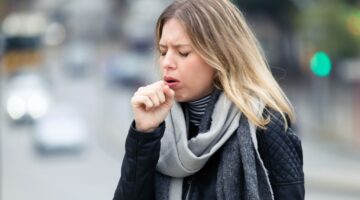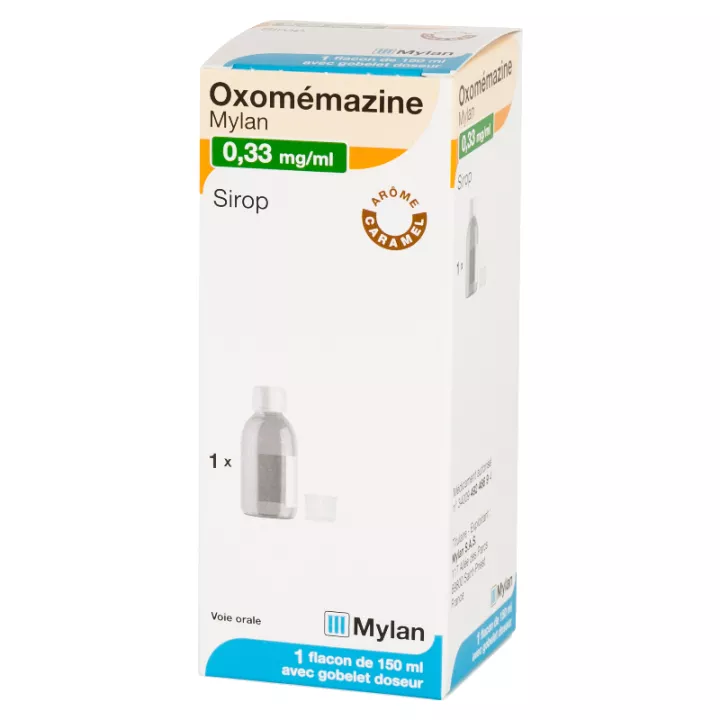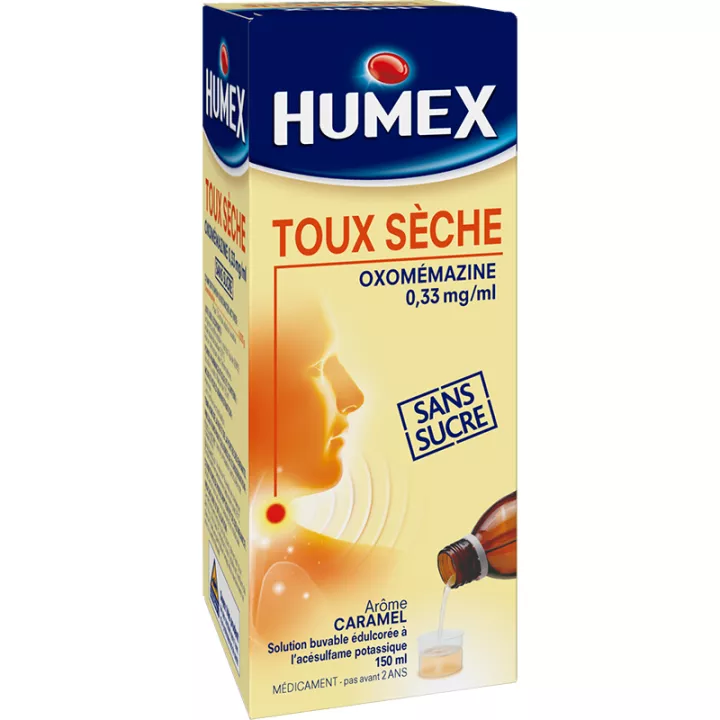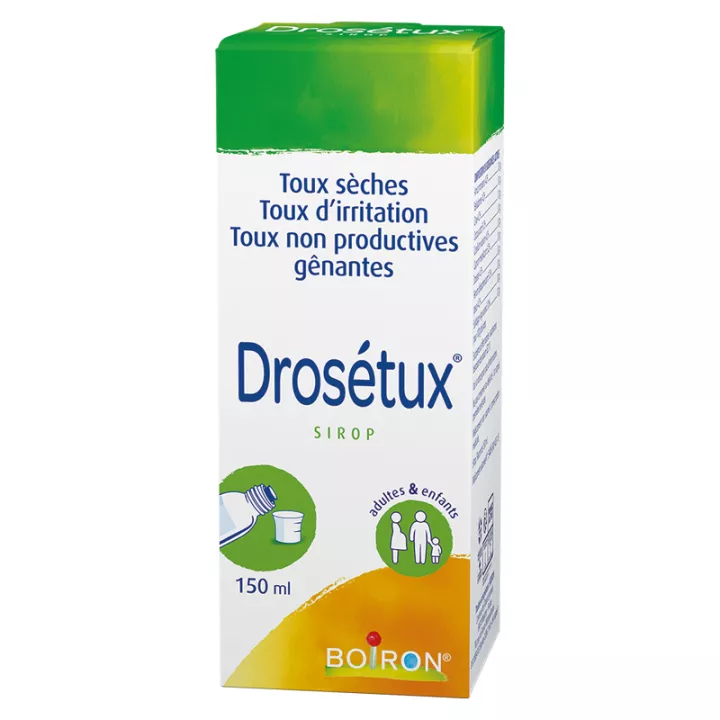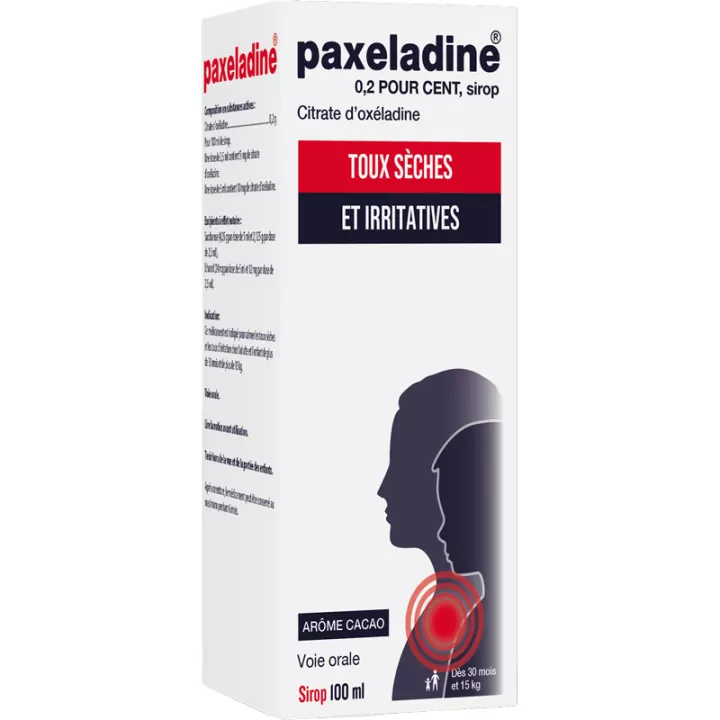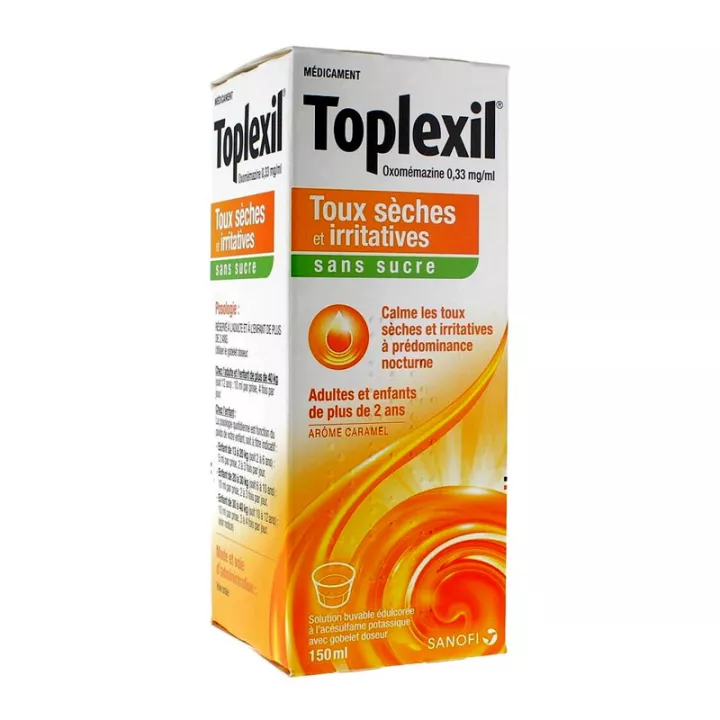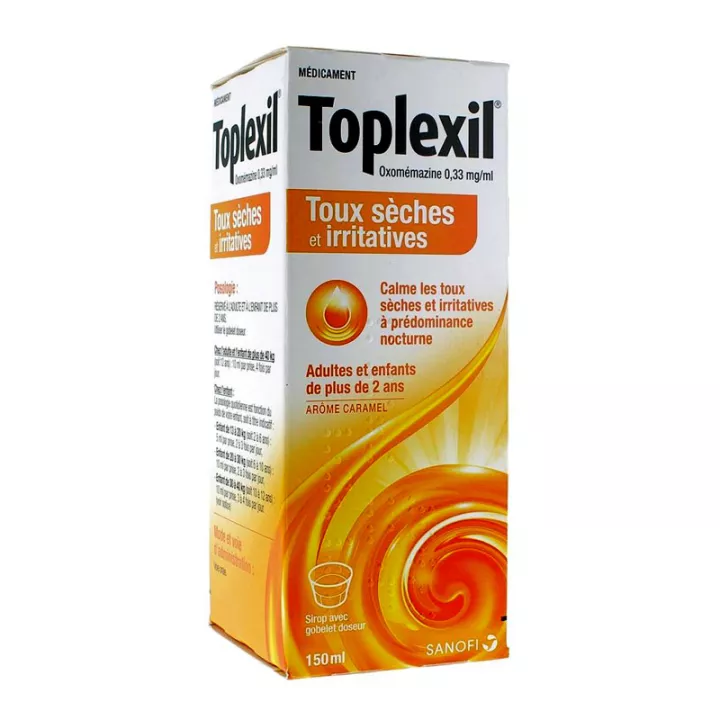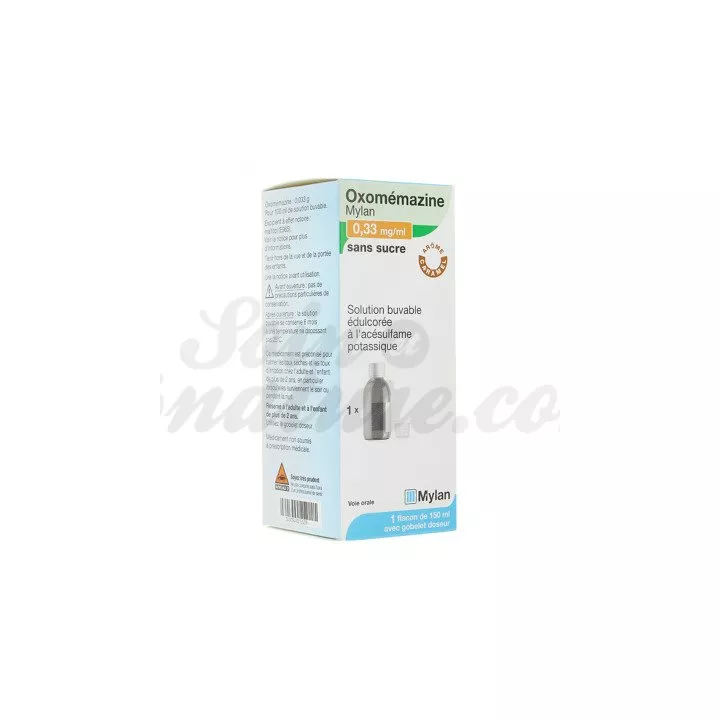NOTICE
ANSM - Last updated: 11/05/2017
Name of the medicinal product
HUMEX DRY OXOMEMAZINE DRINK 0.33 mg / ml, syrup
oxomemazine
framed
Read this leaflet carefully before you start taking this medicine. It contains important information for your treatment.
· If you have any further questions, ask your doctor or pharmacist.
· Keep this leaflet, you may need to read it again.
· If you need more information and advice, ask your pharmacist.
· If symptoms worsen or persist, consult a physician.
· If you notice any side effects not listed in this leaflet, or if you experience any of the effects listed as serious, please tell your doctor or pharmacist.
Review summary
In this notice :
1. WHAT IS HUMEX DRY OXOMEMAZINE DRINK 0.33 mg / ml, syrup AND WHAT IT IS USED FOR?
2. BEFORE YOU TAKE HUMEX DRY OXOMEMAZINE DRINK 0.33 mg / ml, syrup?
3. HOW TO TAKE HUMEX DRY OXOMEMAZINE 0.33 mg / ml, syrup?
4. WHAT ARE POSSIBLE SIDE EFFECTS?
5. HOW TO STORE HUMEX DRY OXOMEMAZINE 0.33 mg / ml, syrup?
6. ADDITIONAL INFORMATION
1. WHAT IS HUMEX DRY OXOMEMAZINE DRINK 0.33 mg / ml, syrup AND WHAT IT IS USED FOR?
Pharmacotherapeutic group
This medicine contains an antihistamine, oxomemazine.
Therapeutic indications
It is recommended to calm dry coughs and coughs of irritation in adults and children over 2 years of age, especially when they occur in the evening or at night.
2. BEFORE YOU TAKE HUMEX DRY OXOMEMAZINE DRINK 0.33 mg / ml, syrup?
List of information needed before taking the medication
If your doctor has told you about an intolerance to some sugars, contact your doctor before taking this medicine.
Cons-indications
Never take HUMEX DRY OXOMEMAZINE 0.33 mg / ml, syrup in the following cases:
· in infants (less than 2 years of age),
· allergy known to any of the constituents, and in particular to antihistamines,
· if you have a history of agranulocytosis (significant decrease in white blood cells),
· if you have difficulty urinating from prostatic or other sources.
· if you have some forms of glaucoma (increased pressure inside the eye).
IN CASE OF DOUBT, IT IS ESSENTIAL TO ASK FOR THE OPINION OF YOUR DOCTOR OR YOUR PHARMACIST.
Precautions for use; special warnings
Take special care with HUMEX DRY OXOMEMAZINE 0.33 mg / ml, syrup:
Special warnings
Coughing is a symptom that can have various origins: respiratory infections, bronchitis, flu, allergy, asthma, whooping cough, irritation, etc ...
In addition, tobacco consumption worsens or maintains cough.
If a fever occurs or persists, accompanied or not by signs of infection (angina ...), pallor or sweating, it will be necessary to consult your doctor.
Do not use this medicine for a cough. In this case, coughing is a natural defense necessary for the evacuation of bronchial secretions.
If the cough becomes oily, is accompanied by clutter, sputum, fever, ask the doctor for advice.
In the case of chronic (long-term) bronchial or lung disease accompanied by cough with sputum, medical advice is essential.
A bronchial fluid (expectorant, mucolytic) should not be combined.
Precautions for use
In case of long-term liver or kidney disease, CONSULT YOUR DOCTOR so that he can adapt the dosage.
Taking this medication requires a MEDICAL ADVICE:
· in the elderly:
o predisposed to constipation, dizziness or drowsiness,
o having prostate disorders;
· in children with asthma or gastroesophageal reflux disease,
· in case of severe heart disease, epilepsy.
PREVENT YOUR DOCTOR before taking this antihistamine.
Refrain from taking alcoholic beverages or medication containing alcohol during this treatment.
Use of this medication is not recommended in patients with fructose intolerance, glucose-galactose malabsorption syndrome, or sucrase / isomaltase deficiency (rare hereditary diseases).
This medicinal product contains 3.7 g sucrose per 5 ml intake and 7.3 g in 10 ml intake, which must be taken into account in the daily diet in the case of a diet low in sugar or diabetes.
Do not expose yourself to sunlight or UVA during treatment.
This medication should be used with caution due to the risk of sedation. Combination with other sedative medicinal products is not recommended ( see section "Other medicinal products and other medicinal products" ).
IN CASE OF DOUBT, DO NOT HESITATE TO REQUEST THE OPINION OF YOUR DOCTOR OR YOUR PHARMACIST.
Interaction with other medicines
Taking or using other medicines:
This medicine contains an antihistamine, oxomemazine. Other medicines contain it. Do not combine them, so as not to exceed the recommended daily dose ( see section "Dosage" ). |
Combination with other sedative medicines is not recommended because of the increased risk of sedation.
If you are taking or have recently taken any other medicines, including medicines obtained without a prescription, talk to your doctor or pharmacist.
Interactions with food and beverages
Refrain from taking alcoholic beverages or medication containing alcohol during treatment.
Interactions with Herbal Medicines or Alternative Therapies
Not applicable.
Use during pregnancy and lactation
Pregnancy
This medication SHOULD NOT BE USED, unless otherwise directed by your doctor, during the first trimester of pregnancy.
If you discover that you are pregnant during treatment, consult your doctor promptly: he alone will be able to adapt the treatment to your condition.
At the end of pregnancy, abuse of this drug may cause adverse effects in the newborn. Therefore, always seek the advice of your doctor before using it and never exceed the recommended dose and duration of treatment.
feeding
This drug passes into breast milk. Due to its pronounced sedative properties, its intake should be avoided in case of breast-feeding.
Ask your doctor or pharmacist for advice before taking any medicine.
Sport
Not applicable.
Effects on ability to drive or use machines
Driving and using machines:
Attention is drawn to the possibilities of somnolence associated with the use of this medication, especially at the beginning of treatment, especially among vehicle drivers and machine users.
This phenomenon is accentuated by the use of alcoholic beverages or medicines containing alcohol.
List of excipients with known effect
Important information about some of the ingredients of this medication:
This medicine contains sucrose.
3. HOW TO TAKE HUMEX DRY OXOMEMAZINE 0.33 mg / ml, syrup?
Instructions for proper use
Not applicable.
Dosage, Mode and / or route (s) of administration, Frequency of administration and Duration of treatment
Administration mode
ORAL WAY.
RESERVED FOR ADULTS AND CHILDREN OVER 2 YEARS.
Use the measuring cup.
Dosage
In adults and children over 40 kg (12 years): 10 ml per dose, 4 times a day.
In children:
The daily dosage depends on the child's weight (1 ml of syrup per kg of body weight per day) or as an indication:
· Child 13 to 20 kg (2 to 6 years): 5 ml per dose, 2 to 3 times daily,
· Child 20 to 30 kg (6 to 10 years): 10 ml per dose, 2 to 3 times daily,
· Child 30 to 40 kg (10 to 12 years): 10 ml per dose, 3 to 4 times a day.
Frequency of Administration
Receptacles must be renewed if necessary and spaced at least 4 hours apart.
Due to the sedative effect, especially at the beginning of treatment, oxomemazine should be preferred.
Duration of the treatment
Treatment should be short (a few days) and limited to coughing times.
If your cough persists, seek advice from your doctor.
If you feel that the effect of HUMEX TOUX DRESS OXOMEMAZINE 0.33 mg / ml, syrup is too strong or too weak: Consult your doctor or pharmacist.
Symptoms and Instructions for Overdose
If you take more HUMEX DRY OXOMEMAZINE 0.33 mg / mL, syrup you should:
Immediately consult your doctor or pharmacist.
Instructions for omission of one or more doses
If you forget to take HUMEX TOUX DRY OXOMEMAZINE 0.33 mg / ml, syrup:
Do not take a double dose to make up for a missed dose.
Risk of withdrawal syndrome
Not applicable.
If you have any further questions on the use of this medication, ask your doctor or pharmacist.
4. WHAT ARE POSSIBLE SIDE EFFECTS?
Description of adverse reactions
Like all medicines, HUMEX TOUX DRESS OXOMEMAZINE 0.33 mg / ml, syrup is likely to have side effects, although not everyone is subject to it.
Some effects require STOPPING IMMEDIATELY TREATMENT AND WARNING YOUR DOCTOR:
· Allergic reactions of type:
o rash (erythema, eczema, purpura, urticaria),
o angioedema (urticaria with abrupt swelling of the face and neck which can cause respiratory discomfort),
o anaphylactic shock (violent allergic reaction endangering vital organs),
o phenomena of sensitization of the skin under the effect of the sun.
· Significant decrease in white blood cells in the blood, which may be manifested by the onset or recurrence of fever with or without signs of infection.
· Abnormal decrease in platelets in the blood that may result in nosebleeds or gums.
Others are more frequent:
· Drowsiness, decreased vigilance, more marked at the beginning of treatment,
· Disorders of memory or concentration, dizziness,
· Motor incoordination, tremors,
· Confusion, hallucinations,
· Dryness of the mouth,
· Visual impairment,
· Retention (accumulation) of urine,
· Constipation,
· palpitations,
· Low blood pressure.
More rarely,
· signs of excitement (agitation, nervousness, insomnia) may occur.
If you notice any side effects not listed in this leaflet, or if any of the side effects gets serious, contact your doctor or pharmacist.
5. HOW TO STORE HUMEX DRY OXOMEMAZINE 0.33 mg / ml, syrup?
Keep out of the reach and sight of children.
Expiration date
Do not use HUMEX DRY OXOMEMAZINE DRINK 0.33 mg / ml, syrup after the expiry date which is stated on the carton or bottle after EXP. The expiry date refers to the last day of the month.
Storage conditions
Before opening : no special precautions for storage.
After opening : the syrup is kept for 6 months at a temperature not exceeding 25 ° C.
If necessary, warnings against visible signs of deterioration
Medicines should not be disposed of via wastewater or household waste. Ask your pharmacist what to do with unused medications. These measures will help protect the environment.
6. ADDITIONAL INFORMATION
Full list of active substances and excipients
What HUMEX TOUX DRESS OXOMEMAZINE contains 0.33 mg / ml, syrup?
The active substance is:
Oxomemazine ................................................. .................................................. .............................. 0.033 g
For 100 ml of syrup.
The other components are:
Sodium benzoate, glycerol, citric acid monohydrate, sodium citrate, caramel flavor *, caramel color (E150c), sucrose, purified water.
* Composition of caramel flavor: vanillin, ethylvanillin, benzaldehyde and propylene glycol.
Pharmaceutical form and content
What is HUMEX TOUX DRY OXOMEMAZINE 0.33 mg / ml, syrup and contents of the pack?
This medication is in the form of a syrup. Bottle of 150 ml.
Name and address of the marketing authorization holder and the holder of the manufacturing authorization responsible for the release of the lots, if different
Holder
URGO HEALTHCARE LABORATORIES
42 RUE DE LONGVIC
21300 CHENOVE
exploiting
URGO HEALTHCARE LABORATORIES
42 RUE DE LONGVIC
21300 CHENOVE
Maker
H2 PHARMA
ZAC LA CROIX BONNET
21 RUE JACQUES TATI
78390 BOIS D'ARCY
LA FRANCE
or
URGO LABORATORIES
AVENUE OF STRASBOURG
ZONE EXCELLENCE 2000
21800 CHEVIGNY SAINT SAUVEUR
Names of the medicinal product in the Member States of the European Economic Area
Not applicable.
Date of approval of the notice
The last date on which this leaflet was approved is {date}.
AMM under exceptional circumstances
Not applicable.
Internet Information
Detailed information on this medicine is available on the Afssaps website (France).
Information for health professionals only
Not applicable.
Other
Not applicable.
